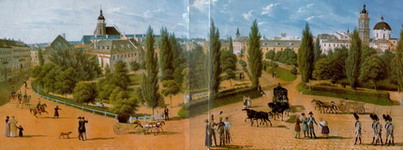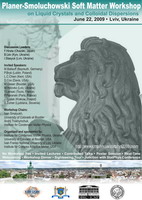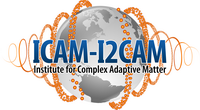PSSM Workshop on Liquid Crystals and Colloidal Dispersions
Tunable Cholesteric Liquid Crystal Color
Liang-Chy Chien, Kent State University
Abstract: Cholesteric liquid crystals (CLCs) in the planar texture possess the unique feature of separating incident light into its left- and right-handed circular components by reflecting one component and transmitting the other.1,2 In a planar aligned CLC with a preselected helical pitch only a single wavelength can be Bragg reflected (monochrome). In addition to the temperature dependence of Bragg reflected wavelength of a CLC, there are two ways to prepare multiple wavelength (or color) reflecting CLCs; one method is by stacking multiple layers of CLCs with different cholesteric pitches to reflect different wavelengths. In this case, the stacking is normally arranged in a fashion that CLC reflecting a shorter wavelength is placed on top and the CLC reflecting a longest wavelength is placed at the bottom of the stacked films. Alternatively, multiple (wavelengths) colors reflection CLCs can be obtained in sequential arrangement in a single layer with CLCs reflecting different wavelengths or colors.
We reported a couple of approaches in tuning the cholesteric color; one is using the photo-induced pitch change with a tunable chiral material to adjust the helix of a CLC to reflect different color through the photo-induced isomerization or racemization, and the other one is by using electric field-induced color change.3 The CLC displays different color pixels at zero voltage and reflects a black color with an applied voltage pulse (bistable). A related report on using light control of cholesteric pitch is reported by doping a CLC with an azobenzene chiral dye.4
Here, we present an electrically-switched color cholesteric display with transmissive and reflective properties in a polymer-stabilized CLC (PSCLC) cell, in which the cell exhibits a anisotropic color reflection from one side of the cell, while transmits the light on the other side of the cell.5 The reflectivity remains in a certain value while the reflected wavelength is electrically switchable. Instead of broadening, the reflection bandwidth decrease slightly with increasing voltage. The tuning range and critical voltage of the initial reflectivity decreasing are controllable by either varying the film thickness or localization of the polymer network in the cell. The CLC cell for electrically-switched reflective wavelength has a threshold at approximately 2.0 V/µm and the electrically-tuned color is blue shifted as the increase in applied voltage with a maximum alteration range of 140 nm.
REFERENCES:
1 W. J. Harper, Molecular Crystals, 1, 325-331(1965).
2 P.G. de Gennes, ed., "The Physics of Liquid Crystals", 2nd ed., Clarendon Press, Oxford, (1993).
3 L.C. Chien, U. Muller, M.-F. Nabor, J.W. Doane, SID 95 Digest, 26, 169 (1995).
J. Cho, U. Muller, F. Vicentini, Y.H. Lin and L.C. Chien, Proc. SPIE, 4658, 14-19 (2002).
4 S. Pieraccini, et al., Chem. Eur. J. 10, 5632 (2004).
5 S.-Y. Lu, L.-C. Chien, Appl. Phys. Lett. 91, 131119 (2007).















